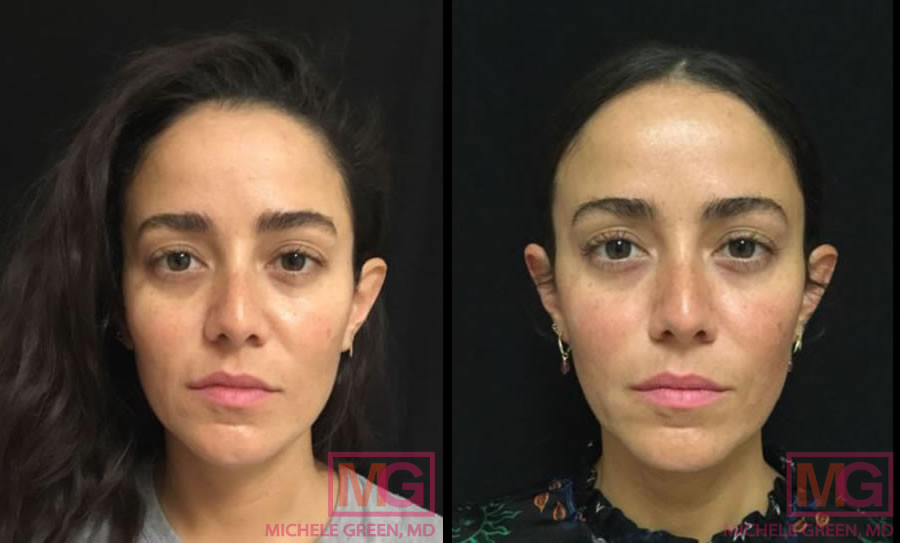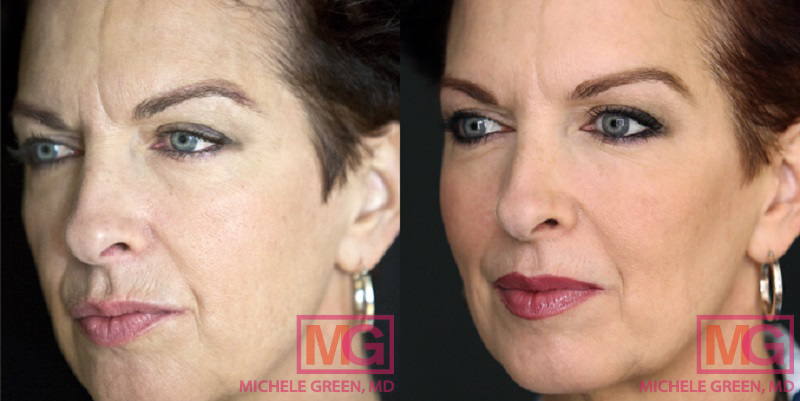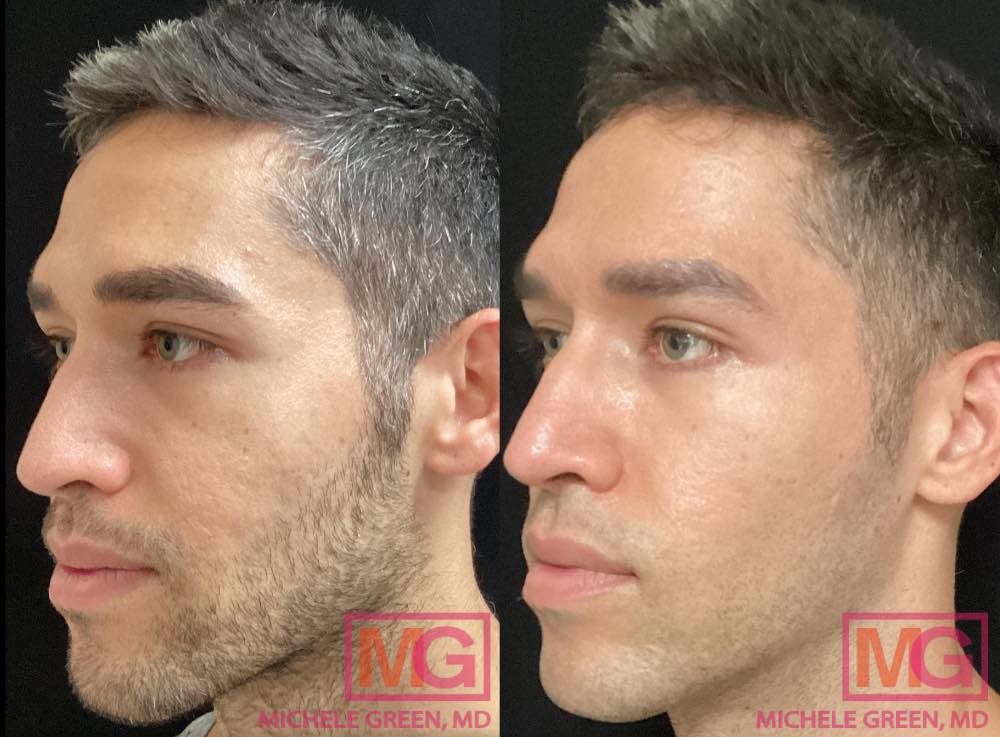Facial Fillers
Facial fillers have transformed the field of cosmetic dermatology, allowing for quick, painless, and immediate facial rejuvenation with natural-looking and long-lasting results. In the past, facial rejuvenation was only achievable with invasive plastic surgery, which required long periods of recovery time and the risk of adverse side effects. Today, facial fillers are one of the most popular cosmetic treatments in the world, allowing patients to forgo invasive cosmetic plastic surgeries for the ease and safety of non-invasive cosmetic injectables, including Botox and hyaluronic acid dermal fillers. Dr. Michele Green is an expert injector in New York City and frequently uses facial fillers in her patients’ treatment plans for long-lasting facial rejuvenation.
Facial fillers are unmatched in their ability to smooth away fine lines and deep wrinkles, restore lost facial volume, enhance key facial features, and improve or create dynamic facial contour. Hyaluronic acid fillers like Juvederm, Restylane, and Belotero immediately restore volume to the skin after just one treatment session and promote collagen production. Biostimulating facial fillers, including Sculptra, Radiesse, and Bellafill, encourage the body to create new collagen, gradually increasing volume and smoothness over a series of treatments. Facial fillers can be used to revitalize a multitude of facial areas, including the cheeks, chin, nasolabial folds, oral commissures, lips, temples, jawline, and tear troughs (undereye hollows). With little to no downtime or side effects and long-lasting results, it’s no wonder that patients turn to facial fillers for their cosmetic rejuvenation. As there are many different types of fillers to choose from, the best way to decide which fillers are right for you is to consult with an expert injector like Dr. Green.
Dr. Michele Green is an internationally renowned board-certified cosmetic dermatologist with over two and a half decades of experience providing some of the world’s most discerning men and women with the best non-invasive cosmetic treatment options available, including injectable fillers. She was one of the first dermatologists in New York to utilize popular dermal filler products like Restylane and Juvederm for facial rejuvenation. Dr. Green is consistently identified as one of NYC’s best dermatologists by Castle Connolly, Super Doctors, New York Magazine, and The New York Times for her dedication to her patients and expertise. She takes a holistic approach and embraces a less-is-more philosophy when it comes to facial rejuvenation, customizing each patient’s treatment plan to incorporate a combination of the in-office treatment options and specially formulated skincare products best suited to their specific skin concerns and unique aesthetic goals. When you consult Dr. Green, she will work with you to achieve and maintain a natural-looking, long-lasting, more youthful appearance.
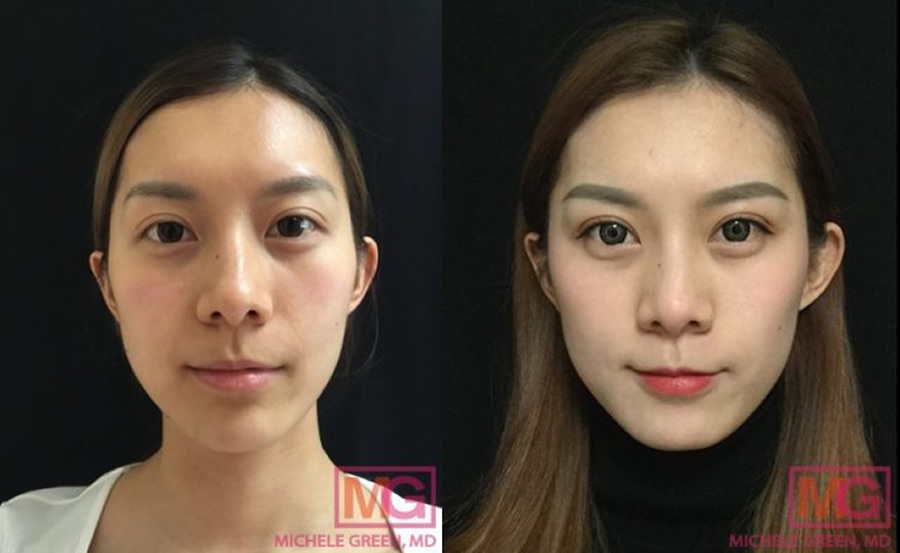
20-29 year old female, Sculptra – 3 months
What is a facial filler?
A facial filler is a cosmetic product designed for injection into the soft tissue to produce an anti-aging effect, create contour, or enhance a facial feature. Facial fillers are often referred to as soft tissue fillers or dermal fillers. Facial fillers come in a wide variety of formulations and styles, allowing expert injectors like Dr. Green to design a treatment plan that best suits the various cosmetic needs in the different areas of the face. Whether a patient is seeking to volumize a naturally thin lip, reduce the appearance of smile lines or the nasolabial fold, treat the look of acne scars, or create a more youthful cheek or defined jawline, treatment with dermal facial fillers can help. Facial fillers are considered to be a non-invasive cosmetic treatment – this essentially means no downtime is associated, unlike traditional plastic surgery procedures. Patients love that they can easily schedule their facial filler treatments and look naturally refreshed and youthful in just a short amount of time.
What do facial fillers do?
Facial fillers are a go-to for men and women interested in reducing the appearance of facial wrinkles. Facial fillers work to restore lost volume in an injected area and stimulate collagen production. By boosting volume, facial fillers can help eliminate or reduce the appearance of volume loss in the cheeks, smile lines (nasolabial folds), marionette lines, and vertical lip lines. They can also be used to improve the appearance of depressed scars, like acne scars, and enhance the contouring and definition of certain facial features, such as the lips, cheeks, or jawline.
How do facial fillers work?
Facial fillers are designed to boost collagen development within the dermis layers, encouraging volume creation in the treatment area. The mechanism by which a given dermal filler can stimulate collagen production ultimately depends on the type of filler used. Though HA fillers are the most commonly used, other dermal filler formulations are available that offer unique benefits and can create volume or contour through other methods. Poly-L-lactic acid, the main component of Sculptra, is used to inject biodegradable volume that is slowly replaced by the body’s collagen development. When you consult with Dr. Green, she will help you determine which dermal filler treatments best suit your particular concerns and unique facial anatomy.
What is a facial filler made of?
A facial filler is comprised of FDA-approved active synthetic versions of naturally occurring substances in the body that have been proven to be safely broken down by the body’s metabolic processes. Some of the most popular fillers, including Juvederm, Restylane, and Belotero, are made of hyaluronic acid to stimulate collagen development and increase skin hydration. Hyaluronic acid is a natural component of the skin that supplies it with suppleness and youthfulness, and this substance already engages with the processes above in the body naturally. Due to its impeccable ability to encourage the body’s natural revitalization processes, hyaluronic acid has become a go-to option for soft tissue and wrinkle fillers. Recent advancements in HA filler formulation allow for cross-linking of the HA molecules to the skin cells, resulting in incredibly natural-looking results.
Many patients also love bio-stimulating fillers like Sculptra, Bellafill, and Radiesse due to their ability to stimulate collagen production. Sculptra is made of poly-l-lactic acid, Radiesse is made of calcium hydroxylapatite, and Bellafill is made of polymethylmethacrylate (PMMA). Once injected, these substances trigger collagenases, or new collagen production, to restore volume and a more youthful, refreshed appearance. Typically, an initial series of treatments is necessary to achieve optimal results. The beauty of these bio-stimulating fillers is that the production of new collagen production will continue long after the filler has been dissolved.
Voluma – 3 weeks before and after
Types of injectable facial fillers
Various facial fillers are available on the market, each offering unique benefits. Though hyaluronic acid fillers are perhaps the most well-known, poly-L-lactic acid, calcium hydroxylapatite, and polymethylmethacrylate fillers are all varieties of facial fillers that can be used to meet specific rejuvenation goals and provide wondrous effects. The goal of any facial filler is to rejuvenate and enhance facial features, including reducing the appearance of fine lines and creases, correcting age-related volume loss, and boosting volume in desirable areas like the lips, chin, or cheeks. Depending on your facial anatomy, unique skin concerns, and cosmetic goals, Dr. Green will help you determine which facial fillers best incorporate into your treatment plan.
Juvederm collection of hyaluronic acid fillers
Juvederm is a popular line of HA fillers from the pharmaceutical giant Allergan, which also makes Botox, CoolSculpting, and many other aesthetic treatments. It offers a variety of formulations and hyaluronic acid concentrations to help patients achieve a more youthful appearance.
- Juvederm Voluma XC increases volume in the cheeks, chin, and midface and is often used by physicians to create a “liquid facelift” by reducing overall facial sagging and minimizing the appearance of jowls. Voluma can last up to 12 months.
- Juvederm Volbella creates subtle lip enhancement and reduces the appearance of perioral lines (lines around the mouth) and “smoker’s lines” (vertical lines above the upper lip). Due to its gentle formulation, it can also reduce the appearance of tear troughs (under-eye hollows), with results lasting up to one year.
- Juvederm Ultra XC restores facial volume and smooths fine lines and wrinkles around the mouth. It is commonly used to provide volume and contour to the lips and can last nine to twelve months.
- Juvederm Ultra Plus XC treats nasolabial folds, smile lines, and marionette lines in the mid and lower face and enhances lip volume and contour. Juvederm Ultra Plus dermal filler lasts approximately nine to twelve months.
- Juvederm Vollure treats the appearance of nasolabial folds, marionette lines, and smile lines and lasts around 18 months.
- Juvederm Volux is FDA-approved to enhance the jawline and reduce the appearance of jowls. Due to its thicker formulation, Juvederm Volux can last anywhere from six to eighteen months.
- SkinVive is one of the newest members of the Juvederm collection. It uses hyaluronic acid microdroplets to promote hydration and smoothness to the skin. SkinVive typically lasts for six months.
Botox & Voluma before and after
Restylane family of hyaluronic acid fillers
Restylane is another prominent product family of HA fillers distributed by Galderma. The Restylane family of fillers offers a similar array of tailored formulations to that of Juvederm products, though the particle size of each brand differs somewhat. Restylane offers fillers custom-designed for rejuvenation, volume, and facial enhancement for pan-facial rejuvenation.
- Restylane-L corrects moderate facial wrinkles in the mouth and tear trough area, subtle, natural-looking lip enhancement, and acne scars. Cosmetic results can last for six to nine months.
- Restylane Lyft treats deep lines and wrinkles, corrects age-related volume loss in the midface, and restores a younger-looking appearance to the hands. Restylane Lyft lasts approximately nine to twelve months.
- Restylane Contour is FDA-approved to augment the cheeks and correct age-related volume loss in the midface. Restylane Contour lasts up to twelve months.
- Restylane Defyne and Restylane Refyne are used to treat severe-to-moderate smile lines and laugh lines and to enhance the chin and jawline. Both facial fillers can last up to one year.
- Restylane Volyme contains a soft formulation that boosts volume and enhances the look of the cheeks, chin, and jawline. Results of Restylane Volume can last up to one year.
- Restylane Kysse utilizes innovative XpresHAn Technology to create plump, enhanced lips and reduce the appearance of fine lines around the mouth. Results with Restylane Kysse can last for one year.
- Restylane Silk contains a small particle size to rejuvenate the lips and perioral lines (fine lines around the mouth). Restylane Silk typically lasts for six or more months.
- Restylane Eyelight is FDA-approved to treat the delicate tear trough area (under-eye hollows) and eliminate the appearance of dark circles under the eyes. It can last for up to eighteen months.
- Restylane SkinBoosters deliver dermal hydration and improve the skin’s overall health through a series of microinjections. Treatment entails multiple sessions spaced one month apart, after which patients can return biannually to maintain and enhance the results.
Belotero hyaluronic acid filler
Belotero is a hyaluronic acid facial filler manufactured by Merz. With a small HA particle size, Belotero can immediately integrate into the skin. Belotero Balance is a one-of-a-kind filler created using the proprietary Cohesive Polydensified Matrix (CPM) process — CPM produces a smooth, flexible hyaluronic acid gel that readily blends into the skin’s natural structure and efficiently and evenly fills in etched-in facial wrinkles and fine lines. This dermal filler product is perfect for correcting the appearance of hollow under eyes caused by a tear trough and smoothing ultra-fine lines around the mouth. Dr. Green prefers to use Belotero to treat the under-eye area, as it eliminates the risk of producing the Tyndall effect as a side effect. The Tyndall effect is caused by light reflecting off the particles within the dermal filler after injection into the skin. However, due to the incredibly small particle size of Belotero and the gentleness of this dermal filler product, the Tyndall effect is not a risk with this injectable filler. The cosmetic results with Belotero typically last for six months.
Radiesse dermal filler
Radiesse is an FDA-approved calcium hydroxylapatite filler to replenish lost collagen under the skin. This particular facial filler relies on a patented microsphere technology to create initial volume in the treatment area while simultaneously igniting the production of new collagen. Through this treatment method, patients can immediately see an improvement in the appearance of fine lines and wrinkles in the treatment area, with continued results as new collagen production begins to replace the calcium hydroxylapatite microspheres being naturally absorbed into the body. Radiesse is a popular facial filler for patients seeking to reduce the appearance of wrinkles and deep lines around the nose and mouth. It can also be used to rejuvenate the hands, contour the jawline, and enhance cheekbones. After an initial series of treatments spaced one month apart, patients will find that their results with Radiesse can last up to two years.
Sculptra dermal filler
Sculptra is an FDA-approved, biocompatible synthetic injectable that stimulates the body’s collagen production process. Sculptra relies on poly-L-lactic acid (PLLA), which has been commonly used in medical products like dissolvable sutures and implants for over two decades. Unlike other dermal fillers, the results from Sculptra injections tend to develop over 4-6 weeks following treatment. Nonetheless, Sculptra is an incredibly popular facial filler option for those seeking a “liquid facelift” treatment, as it uses a deep injection technique to create long-lasting results for up to two years. Sculptra is excellent for patients interested in volume restoration in the cheeks, temples, jaw, and chin, as well as for overall facial rejuvenation along the forehead and mouth area. In addition, Sculptra is commonly used for butt augmentation, knee rejuvenation, hand revitalization, and the reduction of stretch marks, cellulite, and acne scars. After full cosmetic correction, the cosmetic results from Sculptra can last more than two years.
Bellafill
Bellafill is comprised of polymethylmethacrylate (PMMA) microspheres combined in a volumizing matrix with purified bovine collagen and lidocaine. This matrix supports and enhances the body’s production of new collagen. While originally approved for reducing the appearance of nasolabial folds and depressed acne scars, Bellafill can also add volume to other areas of the face, such as the cheeks. It has been reported to last from two to five years.
Which areas of the face can you inject facial fillers into?
- Cheeks
- Temples
- Smile lines (nasolabial folds)
- Marionette lines (lines running vertically from the mouth to the chin)
- Oral commissures
- Jawline
- Chin
- Tear troughs (undereye hollows)
- Upper and lower lips
- Smoker’s lines or perioral lines (lines around the lips)
- Deep wrinkles and skin folds
Who is a good candidate for facial filler treatment?
Many people may initially feel apprehensive about getting cosmetic treatment with facial fillers, fearing that they aren’t a good candidate. A good candidate for treatment with facial fillers is any patient aged 21 or older who is generally in good physical health and has realistic expectations regarding the results of their treatment. Patients who want to replenish lost volume, enhance facial contouring, have mild to moderate facial wrinkles, or are interested in naturally enhancing their facial features (such as lip augmentation) are all excellent candidates for facial fillers. If you have allergies or a pre-existing skin condition, you should talk to Dr. Green before having any treatment with dermal fillers. Additionally, dermal fillers are contraindicated for pregnant or currently breastfeeding women.
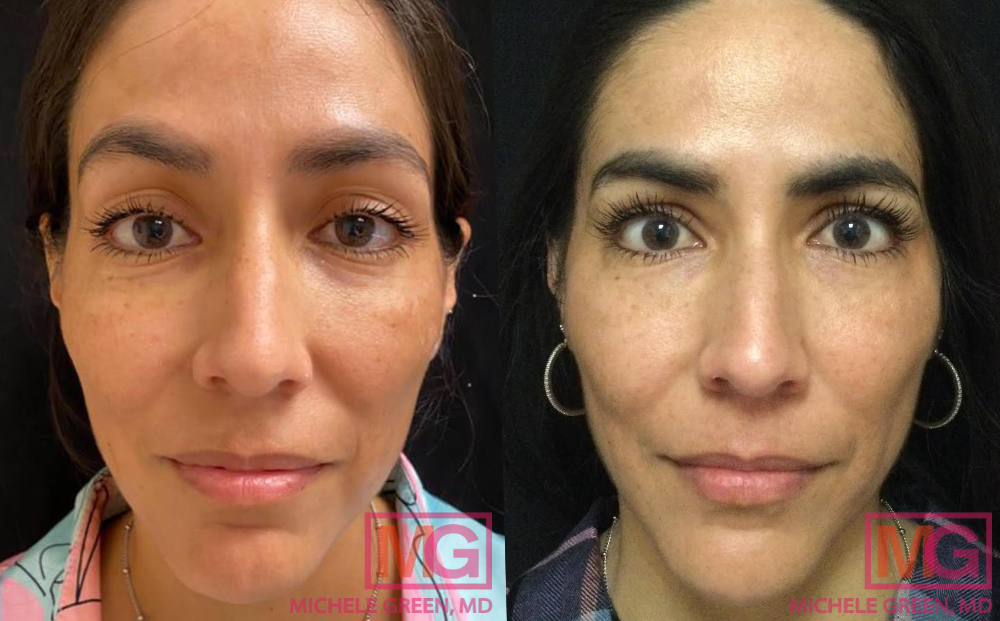
What is the process of getting facial fillers?
The process for getting facial fillers is very simple. First, you will schedule a consultation with board-certified dermatologist Dr. Michele Green in her private Upper East Side dermatology office. During your consultation, she will assess your medical history, facial anatomy, skin concerns, and aesthetic goals to confirm you are a good candidate for facial fillers and develop a unique treatment plan for your facial rejuvenation. Medical photography will be taken at this time to track the future progress of treatment.
To reduce the risk of bruising, Dr. Green recommends avoiding any blood thinners, NSAIDs (Aspirin, Aleve), vitamin E, fish oil, and multivitamins for one week before the procedure. Patients prone to bruising can use topical or oral Arnika Forte, an herbal supplement, a few days before the procedure to prevent bruising or accelerate the healing of any bruising.
An hour before your facial filler appointment, a topical numbing cream should be applied to the treatment area to minimize any discomfort during the procedure. When you arrive at the office, the numbing cream will be cleaned, and the skin will be sterilized for treatment. Dr. Green will then masterfully inject the selected facial fillers into the treatment areas. An ice pack will immediately be placed on the injected areas to minimize swelling and bruising. Aftercare information will be reviewed based on the type of facial filler used during treatment. Dr. Green invites her patients to return for a follow-up two weeks after the procedure to check on the results from treatment and see if any additional filler is needed.
Potential side effects of facial filler treatment
Facial filler treatment is incredibly safe, especially in the hands of an expert injector like Dr. Green. Some of the most common side effects from treatment include:
- Bruising
- Redness
- Swelling
- Nodule formation
- Pain
- Localized infection
- Tyndall effect—This refers to a blue tint appearance in the treatment area caused by light reflecting off the gel particles in the filler. It often occurs with filler injections in the tear trough area and can be prevented by choosing a small particle-sized filler like Belotero for treatment.
In general, dermal filler injections cause mild skin redness, swelling, or bruising at or near the injection sites. These side effects resolve on their own shortly after the filler procedure. If lumps or nodules occur and do not resolve on their own, patients should return to their injection for assessment. Hyaluronic acid fillers like Juvederm, Restylane, and Belotero can be dissolved with hyaluronidase injections. Unfortunately, facial fillers like Sculptra, Radiesse, and Bellafill cannot be dissolved, and it is important to have your facial filler treatment performed by an expert injector to avoid any unwanted side effects.
Though rare, allergic reactions can be serious, and it is imperative to disclose any allergies to your injector before treatment. When facial fillers are improperly performed, more serious side effects can occur, including blindness, stroke, and skin necrosis if the filler is injected into a blood vessel. It is essential to select a board-certified dermatologist like Dr. Green in NYC who has the knowledge and expertise to administer your facial fillers safely and effectively.
How long does it take for facial filler to settle?
After having cosmetic facial filler injections, patients may feel anxious and excited to see the final results as soon as possible. While it may be possible to see some of the results immediately after the procedure, there is often a mild amount of swelling at or near the injection sites. The length of time it takes a facial filler to settle fully varies widely depending on the type of dermal filler being used. In general, however, it can take two weeks for a facial filler to settle.
Some hyaluronic acid fillers can settle within several days of the filler procedure. Radiesse may appear firm on the skin’s surface at first, but this should resolve on its own within several weeks. Sculptra is a unique type of dermal filler composed of a substance called poly-L-lactic acid. While the results of hyaluronic acid filler injections are visible very quickly, results from Sculptra injections take much longer to become observable. The cosmetic results of Sculptra start to appear 4-6 weeks following the filler procedure.
How long does facial filler last?
Facial filler injections provide temporary or semi-permanent results, depending on the type of dermal filler used. Most hyaluronic acid dermal fillers produce cosmetic effects that last between six and twelve months, ultimately depending on the patient’s metabolism, the amount of dermal filler product used, and the type of HA filler used. Cosmetic injectables that are composed of substances like calcium hydroxylapatites and poly-L-lactic acids, such as Radiesse and Sculptra, respectively, usually last longer than hyaluronic acid dermal fillers. Radiesse and Sculptra injections generally last two to five years and are considered semi-permanent treatments.
The fact that facial fillers are semi-permanent rather than permanent is considered a great benefit. As we age, our skin concerns, needs, and aesthetics evolve. The semi-permanence of facial fillers allows for adaptability in your cosmetic treatment plan. As your cosmetic goals shift over time, Dr. Green will adjust your custom treatment plan so that you consistently get stunning, natural-looking, and long-lasting results.
What facial filler lasts the longest?
The longevity of any facial filler will depend on its formulation, the patient’s metabolism, and the area of the face that is treated. Facial fillers such as Sculptra and Radiesse last the longest, with results holding for two years or more after an initial series of treatments due to their ability to stimulate collagen production long after the filler has left the body. Certain hyaluronic acid fillers, including Restylane Lyft and Juvederm Vollure, can last for twelve or even eighteen months. Patients often engage in annual or biannual facial filler treatment sessions with Dr. Green to maintain their optimal cosmetic results.
Can facial fillers be dissolved?
The composition of the facial filler will determine if it is dissolvable. Hyaluronic acid facial fillers are a unique type of dermal fillers in that treatment effects can be completely dissolved and reversible through hyaluronidase injection. Hyaluronidase is an enzyme that breaks down hyaluronic acid naturally in the body. Hyaluronic acid facial fillers can be dissolved by injecting hyaluronidase into the treatment area. It is important to remember that residual swelling can affect the treatment area for up to two weeks after the filler procedure. Patients who observe lumps or bumps remaining two weeks after their hyaluronic acid filler injections should follow up with their injector for hyaluronidase injections. Patients who do not like the results of their dermal filler injections can also be treated with hyaluronidase, so long as they are initially treated with hyaluronic acid fillers. Other facial fillers are considered semi-permanent, meaning their results will fade over 1-5 years. Sculptra, Radiesse, and Bellafill are examples of semi-permanent types of dermal fillers that cannot be dissolved or removed. It is important to consult with an expert injector like Dr. Green in NYC to ensure the best cosmetic results.
Where to get facial fillers near me?
The FDA considers facial fillers to be a form of medical device implant, and it is crucial to consult a board-certified dermatologist to inject your dermal fillers, who has the knowledge, expertise, and training to administer your cosmetic injections safely. Facial fillers should always be performed in a medical setting and by a board-certified medical professional. Facial filler injections performed by inexperienced or unlicensed injectors can result in greater risks during treatment, including filler being injected into a blood vessel, leading to vision impairment, skin necrosis, and stroke. When looking for a healthcare provider or injector for facial fillers, consulting with a board-certified dermatologist like Dr. Green is best. Dr. Green has over 25 years of experience using injectables in her patient’s treatment plans. She will ensure that your facial filler injections are performed safely to help you achieve the best results possible.
Can I combine facial fillers with other cosmetic procedures?
Botox and facial fillers are excellent treatment options for reducing the appearance of fine lines and wrinkles. These cosmetic injectables should be considered complementary treatments above all else. They can be used together in a patient’s treatment plan to achieve a more youthful appearance and pan-facial rejuvenation.
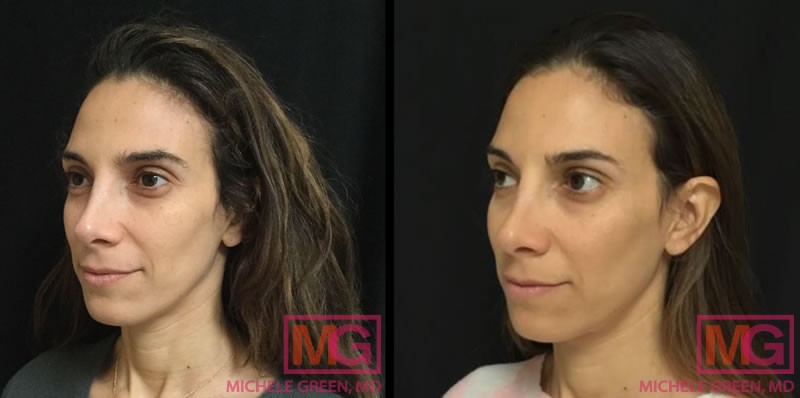
Juvederm Voluma before and after
FAQs about facial fillers?
What is the best facial filler?
When it comes to naming the “best facial filler” or identifying the ideal facial filler treatment, there is no one “best” option for all patients. Each facial filler product offers a unique formulation that provides its own set of benefits, meaning that what’s best for one patient may not be best for the next. The best way to determine which facial fillers are best suited to your facial anatomy, specific concerns, and unique aesthetic goals is by consulting with an expert in the field of cosmetic dermatology, such as internationally renowned board-certified dermatologist Dr. Michele Green in NYC. Dr. Green has a background in aesthetics and art, and as an artist, her approach to facial rejuvenation is maintaining and restoring classic beauty. She takes on a less-is-more philosophy regarding dermal fillers, which always yields beautiful, natural-looking, and long-lasting results. When you work with Dr. Green, she’ll be able to assess your medical history, current skin condition, and aesthetic goals to determine which dermal fillers may be right for you.
Are facial fillers the same as Botox?
While both facial fillers and Botox are excellent treatment options for facial rejuvenation, they are different. Facial fillers are injectables used to treat age-related volume loss and enhance and define certain facial features. They are comprised of ingredients like hyaluronic acid, calcium hydroxylapatite, and poly-L-lactic acid, which smooth the skin and increase collagen synthesis. Facial fillers can be injected into various areas of the face, including the cheeks, midface, lips, jawline, and chin.
On the other hand, Botox is the gold-standard cosmetic treatment option for reducing dynamic fine lines and wrinkles, or wrinkles that result from repeated facial expressions, such as frowning, squinting, or raising the eyebrows. Botox and other injectable neurotoxins, including Dysport and Xeomin, are derived from Botulinum toxin type A. These neurotoxins are injected into targeted muscles responsible for the facial expressions that create dynamic facial wrinkles, resulting in a “freezing” or temporary paralysis of nerve signaling. By limiting the motion and overuse of these muscles, Botox can ultimately be used to reduce the appearance of fine lines and wrinkles related to facial expressions. It can even help prevent these wrinkles from forming in the first place. Since Botox targets dynamic wrinkles, it is utilized primarily for forehead wrinkles, glabella lines (frown lines), and crow’s feet (lines around the eyes).
Are facial fillers safe?
Of course! The FDA has approved all of the facial filler products Dr. Green uses in her private dermatology office in NYC’s Upper East Side neighborhood. However, your dermal filler treatment must be performed in a medical setting with an experienced professional to guarantee safety. While there are typically minimal side effects, if any, it is important that your injector can advise should anything problematic occur. Additionally, having facial fillers with an inexperienced injector can lead to more severe side effects, including vision problems and skin necrosis if the filler is unintentionally injected into a blood vessel. When you have facial filler injections with board-certified dermatologist Dr. Green, you can rest assured that you are being treated by an expert injector with over 25 years of experience and the ability to provide you with a safe, comfortable, effective, and satisfactory facial filler treatment.
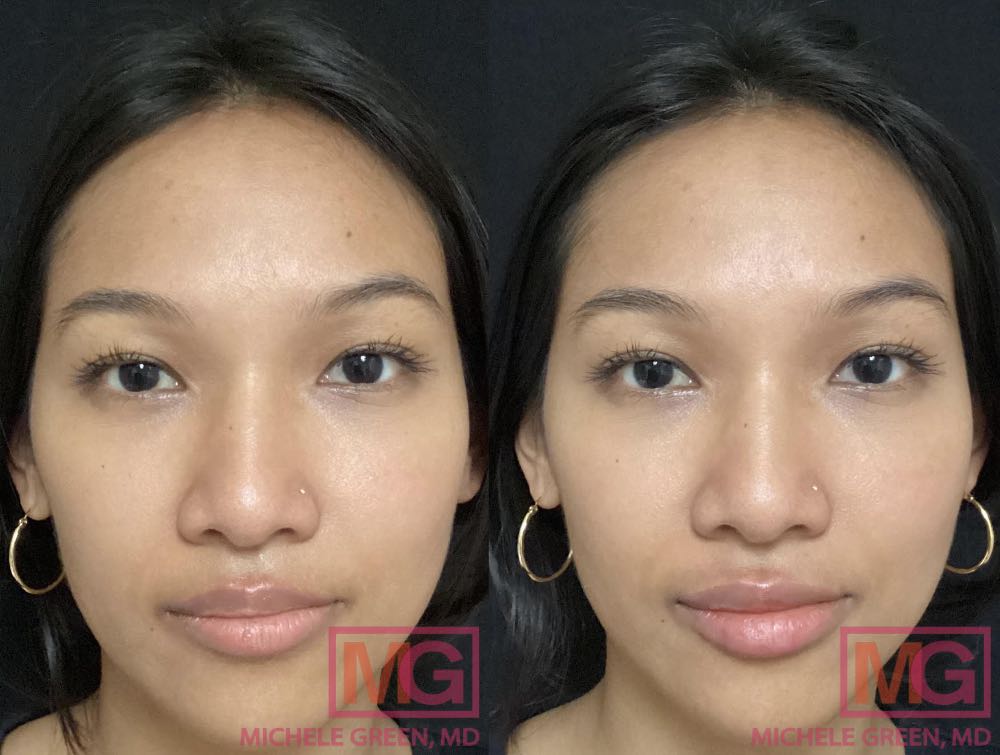
Do facial fillers hurt?
No! Facial filler injections with Dr. Green are essentially painless. Dr. Green utilizes dermal fillers that have been compounded with lidocaine, an anesthetic that enhances patient comfort during the filler procedure. Dr. Green also provides her patients with a topical numbing cream to further reduce discomfort during dermal filler injections.
Are facial fillers permanent?
No. Facial filler injections produce temporary, although long-lasting, results. Hyaluronic acid fillers like Juvederm, Restylane, and Belotero typically last for six to twelve months, while biostimulators like Sculptra, Radiesse, and Bellafill can last for two years or more. The materials that facial fillers are composed of are naturally broken down by the body over time, and maintaining ideal cosmetic results requires engaging in subsequent treatment sessions. While some may view this aspect of facial fillers as a disadvantage, many patients like the fact that they can adjust their dermal filler treatments to their needs as they age.
Which facial filler lasts the longest?
Typically, biostimulating fillers last longer than hyaluronic acid fillers. The type of dermal filler that lasts the longest is called Bellafill, which is made of a substance called polymethylmethacrylate. Bellafill injections produce cosmetic results that can last up to five years. Following Bellafill is Sculptra, a type of dermal filler composed of poly-L-lactic acid. Once ideal rejuvenation results have been achieved with Sculptra injections, the effects last up to two years. Hyaluronic acid dermal fillers, such as Restylane and Juvederm, are temporary treatments that produce cosmetic results lasting 6 to 12 months. While there is a range in terms of longevity, almost all facial filler injections offer long-term positive benefits when it comes to achieving overall healthy skin and inducing collagen production. Additionally, patients can maintain their ideal cosmetic results by having touch-up treatment sessions of dermal filler injections. When you consult with expert injector Dr. Michele Green at her private dermatology office in Manhattan’s Upper East Side, she will work with you to create a customized treatment plan and timeline for your facial filler injections that best suit your needs and goals.
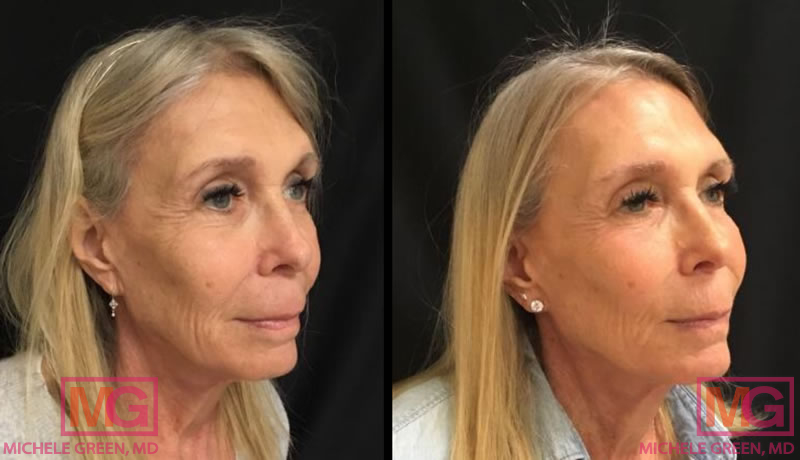
Fillers in Cheek area – before and after photo
Can facial fillers be removed?
Dermal fillers are typically made of substances that are naturally metabolized in the body over time, which means that the effects are only temporary. One of the benefits of dermal fillers, like Juvederm and Restylane, is that the results are not permanent and can be easily dissolved if you are unhappy with the cosmetic results. Facial fillers have become exceedingly popular over the years, particularly due to their temporary nature. They can be an excellent option for patients seeking a more flexible alternative to permanent cosmetic surgery.
Can dermal fillers migrate?
Yes, dermal fillers can migrate, but they can be easily reversed through hyaluronidase injections. Using improper injection technique. It is crucial to seek facial filler treatment from an expert injector such as board-certified dermatologist Dr. Green, who holds over 25 years of experience treating her patients with non-invasive cosmetic injectables.
How much do facial fillers cost?
The total cost of facial filler injections will depend upon several factors, including the geographic location of the medical office in which you are treated, the number of dermal filler syringes used, and the types of dermal fillers used. Patients who need to use a greater amount of dermal filler should expect the total cost of their treatment to be higher than patients using just a single syringe. Additionally, the experience level of your injector is one of the most influential elements when it comes to determining the total cost of treatment. It is often more inexpensive to have dermal filler injections with a nurse injector in a medical spa or salon setting than with an experienced board-certified dermatologist. However, it is worth being extremely selective when it comes to choosing an injector to guarantee that you achieve satisfactory cosmetic results and to ensure that you do not encounter any unwanted or serious side effects. When you choose to work with an expert injector, like Dr. Michele Green in NYC, you guarantee that your treatment is patient-centered and your results are exceptional. If you experience a rare side effect, Dr. Green has the experience and knowledge to treat and resolve any concern.
Do facial fillers cause cancer?
No. There is no evidence to suggest that facial fillers are linked to or cause cancer. Facial fillers are thoroughly studied by medical researchers and are FDA-approved due to their safety and efficacy.
Can facial fillers cause Bell’s palsy?
Bell’s palsy is a condition characterized by temporary facial paralysis. Symptoms include weakness, drooping, twitching, excessive tearing, and dry eye or mouth. While extremely rare, facial fillers can cause Bell’s palsy or temporary nerve damage when injected into or too close to a nerve. As such, it is always recommended that facial fillers be performed by a board-certified dermatologist like Dr. Green, who has the expertise and knowledge of facial anatomy to perform facial filler injections safely.
Are facial fillers bad for you?
No. Facial fillers are incredibly safe and effective in rejuvenating the face to create a more youthful-looking appearance. The FDA has approved them due to their continued safety and efficacy in cosmetic treatments. They are composed of naturally occurring substances, such as hyaluronic acid or poly-L-lactic acid, to restore lost volume in the skin and smooth the appearance of fine lines and wrinkles. Since these substances are made naturally in the body, the body is able to metabolize and excrete them out of the body over time. Since facial fillers are temporary, patients can customize their treatment plan at each session as their skin concerns change.
Is 70 years old too old for facial fillers?
No! There is no upper age limit when it comes to dermal filler injections. In fact, many individuals, well into their 70s and 80s, continue to have facial filler injections to maintain a natural-looking, more youthful appearance. Many older patients are not surgical candidates and do not want to have the risk of an invasive surgical procedure. Dermal fillers and other cosmetic injectables like Botox are excellent non-invasive treatment options for combatting the signs of aging for adults of any age, so long as your skin is healthy and you are continuously satisfied with the results of your treatment. If you are considering having cosmetic treatment and want to understand better whether or not you are an appropriate candidate for dermal filler injections, schedule a consultation with Dr. Michele Green in NYC. Dr. Green takes the time to carefully construct a personalized treatment plan that caters to your unique skin concerns and cosmetic goals. When you choose to work with Dr. Green, you know you’re entrusting an experienced, skillful, and knowledgeable injector who can deliver the best cosmetic results.
Do dermal fillers ruin your face?
Facial fillers do not ruin your face. When an experienced board-certified medical professional performs facial filler injections, there is a very low risk of experiencing any serious negative side effects. However, it is important to note that patients are at increased risk for developing more severe unwanted side effects when having dermal filler injections in a non-medical setting or with inexperienced injectors. Medical spas and other aesthetic services often advertise that they offer treatment with dermal fillers. However, the injectors in these settings don’t always have the training required to avoid or respond to negative side effects. To reduce the risk of encountering an adverse event, you must work with an experienced injector with extensive medical training, such as Dr. Green. Dr. Green is a board-certified cosmetic dermatologist with over two and a half decades of experience safely performing cosmetic injectable treatments. For Dr. Green, the safety and satisfaction of her patients is always her top priority.
What is fat grafting?
Autologous fat injections, or facial fat grafting, is a surgical procedure used to correct textural irregularities. During this procedure, liposuction is performed to collect fat from one area of the body, which is purified before being injected into another body area. Fat grafting procedures are performed by a board-certified plastic surgeon in a medical setting and can be done to augment the face, breasts, buttocks, hips, and even the hands and feet. Fat transfer procedures are typically much more costly than non-invasive treatment options for rejuvenation, require significantly more downtime, and are associated with greater and more severe potential side effects. It is important to consult with an expert in cosmetic dermatology, such as Dr. Michele Green in NYC, to determine whether facial fillers or a fat transfer is better suited to your facial anatomy, specific concerns, and ultimate aesthetic goals.
Where do I go to have dermal fillers injected in my face?
The FDA considers facial fillers medical device implants, so it is important to seek out an injector who has the training, knowledge, and qualifications to perform injections. Injections performed by an unqualified injector can result in a greater risk of unwanted or severe side effects. Additionally, facial filler injections should only be performed in a sterile medical office and should not be purchased online. Consulting with a board-certified dermatologist like Dr. Michele Green is crucial to ensuring that your facial filler treatment is both safe and effective. Dr. Green is a member of the American Society of Dermatology, which closely regulates the safety and practice of facial fillers. With over two and a half decades of experience, Dr. Green will perform your facial filler injections in her private Upper East Side dermatology office to help you achieve pan-facial rejuvenation with long-lasting results.
How do I get started with facial fillers in New York City today?
Facial fillers have revolutionized the world of cosmetic dermatology, nearly eliminating the need for many invasive plastic surgery procedures that usually require adequate planning and significant downtime. Facial fillers are used to restore age-related volume loss, stimulate collagen production, reduce the appearance of fine lines and wrinkles, improve the appearance of depressed scars, and enhance the contouring and definition of facial features. Fillers like Juvederm, Restylane, Sculptra, Radiesse, and Bellafill provide stunning results with little to no downtime or side effects, helping men and women across the globe achieve and maintain natural-looking, long-lasting facial rejuvenation. Dr. Green was one of the first dermatologists in NYC to offer facial fillers like Restylane and Juvederm to her patients. If you are looking to achieve pan-facial rejuvenation and a natural, more youthful-looking appearance, Dr. Green is here to help.
Dr. Michele Green is an internationally renowned expert in cosmetic dermatology, recognized and appreciated for her cosmetic artistry, holistic approach, and less-is-more philosophy. Dr. Green boasts over 25 years of experience providing some of the world’s most discerning individuals with the best facial filler injections, laser treatments, chemical peels, microneedling, and more. She is consistently voted one of NYC’s best dermatologists by Castle Connolly, Super Doctors, New York Magazine, and The New York Times for her dedication to her patients and expertise. Dr. Green takes pride in the relationships she builds with her patients and will work with you to design a treatment plan incorporating the best skin care and in-office treatment options for you. Whether your goal is to restore age-related volume loss, reduce the appearance of fine lines or deeper wrinkles, enhance key facial features, or pan-facial rejuvenation, Dr. Green will help customize a cosmetic treatment plan that works best for you. Don’t hesitate to contact us online today or call our NYC office at 212-535-3088 to schedule your consultation with Dr. Green and discover how to get started with looking and feeling like your very best.
 212-535-3088
212-535-3088 